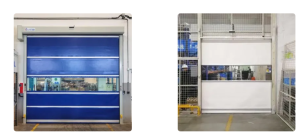The industrial world often grapples with the decision of selecting the most suitable rolling shutters, given the plethora of options available in the market. This choice becomes pivotal as these shutters play a crucial role in ensuring security, controlling internal environments, and facilitating efficient operations within various facilities. Among the array of options, discerning the best fit involves a thorough evaluation of specific needs, including speed, durability, maintenance, and energy efficiency. Herein, we explore several types of rolling shutters and delve into how certain varieties, like fast action doors, can potentially stand out as superior choices.
Traditional Rolling Shutters These are commonplace in many industrial setups, revered for their robustness and enhanced security features. Comprising interlocked slats that roll down to close and wind up on a barrel to open, they provide a sturdy barrier against intrusions and environmental elements. However, they fall behind when it comes to operating speed and frequent maintenance needs, not to mention their manual operation can be cumbersome and time-consuming.
Insulated Rolling Shutters Tailored for energy conservation, these shutters come with insulated laths, reducing heat loss and aiding in maintaining internal temperatures. While they offer energy savings and are apt for premises requiring temperature control, they still share the same setbacks as traditional rolling shutters, particularly concerning operational speed and space requirements.

Transparent or Perforated Rolling Shutters Offering an elegant solution for commercial outlets needing both security and display, these shutters allow visibility while being closed. Despite their aesthetic appeal and the advantage of transparency, they compromise slightly on security and aren't typically robust enough for high-demand industrial environments.
Fast Action Doors A revolutionary solution in industrial closing systems, fast action doors excel where traditional models falter. Designed for speed, they operate seamlessly within high-traffic areas, reducing time spent waiting at entry points, and thereby enhancing operational efficiency. overhead door high speed door.Their rapid movement minimizes air leakage, helping maintain internal climates, saving energy, and protecting sensitive goods from environmental exposure. Additionally, fast action doors are low-maintenance, self-repairing, and occupy less space, addressing several drawbacks associated with standard rolling shutters.
Assessing the Best Fit Determining the "best" rolling shutter is subjective to the specific demands of a facility. Traditional models may suffice for standard security needs, but they do not support efficiency and energy conservation like fast action doors. Meanwhile, insulated shutters are beneficial for thermal regulation but don’t solve the issue of operational speed.
Given these insights, it emerges that for premises prioritizing swift movement, energy conservation, and operational efficiency, fast action doors take precedence. They represent a comprehensive solution, amalgamating the benefits of security and speed while also addressing energy and maintenance concerns. Facilities aiming for optimized workflow and reduced overhead costs will find fast action doors aligning perfectly with their objectives, marking them as arguably the best type of rolling shutters available in the contemporary market.